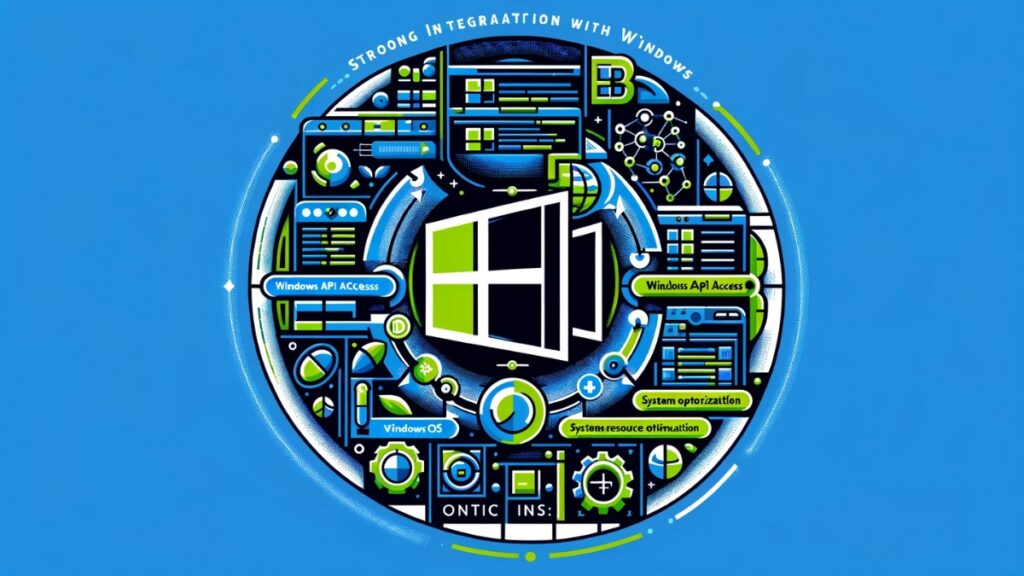Visual Basic (VB), since its inception, has played a pivotal role in the world of programming, particularly in multimedia application development. Originally developed by Microsoft, VB emerged as a tool that transformed the way Windows applications were created, making programming more accessible and intuitive. This section delves into the origins of Visual Basic, its evolution, and how it revolutionized Windows application development, especially in multimedia contexts.
The Genesis of Visual Basic
Visual Basic was conceived with the idea of making programming more user-friendly. It integrated the simplicity of BASIC (Beginner’s All-purpose Symbolic Instruction Code) with a graphical interface tailored for the Windows operating system. This amalgamation resulted in a programming environment where developers could visually design the user interface of applications, a significant shift from the text-heavy coding process prevalent at the time.
Visual Basic: A Revolutionary Tool
The introduction of Visual Basic marked a new era in application development. With its ‘drag-and-drop’ interface, it allowed developers to create user interfaces by simply placing elements like buttons, text boxes, and sliders on a canvas. This method not only simplified the design process but also reduced development time significantly. VB was among the first to introduce event-driven programming, a paradigm where actions are triggered by user interactions or system events, rather than the linear sequence of commands in traditional programming.
The Impact on Multimedia Applications
Visual Basic’s capabilities extended well into the realm of multimedia. It provided robust tools for handling various media types, such as audio and video files, animations, and images. VB’s ease of use and integrated development environment (IDE) made it an ideal choice for developers working on multimedia projects. The language’s ability to interact seamlessly with Windows APIs and its support for ActiveX controls further enhanced its suitability for multimedia applications.
VB.NET and Multimedia
With the advent of the .NET framework, Visual Basic underwent a significant transformation to become VB.NET. This change brought more robust object-oriented programming features and better integration with the .NET ecosystem. VB.NET continued to support multimedia application development with enhanced features, making it a strong tool for modern multimedia solutions.
Core Features of Visual Basic for Multimedia Projects
Visual Basic (VB), renowned for its simplicity and power, is packed with features that make it an ideal choice for multimedia application development. This section focuses on the core features of Visual Basic that are particularly beneficial in multimedia projects, such as its event-driven programming model, Integrated Development Environment (IDE), rich libraries, and strong integration with the Windows operating system.
Event-Driven Programming
One of the most significant features of VB is its support for event-driven programming. This paradigm is centered around the concept that actions (code executions) are triggered by events, like user actions (clicks, keypresses) or system-generated events. This approach is particularly beneficial in multimedia applications where user interaction with media elements is frequent.
- Example: In a VB-based media player, a button click event can be linked to play or pause media, providing an intuitive interface for users.
Integrated Development Environment (IDE)
VB’s IDE is a comprehensive toolkit that significantly enhances developer productivity. It allows for writing code, designing interfaces, testing functionality, and debugging, all within a single environment. Key features of the VB IDE include:
- Drag-and-Drop Interface: Simplifies the UI design process.
- Real-Time Feedback: Offers immediate visual feedback for layout changes.
- Code Editor: Facilitates writing and managing code efficiently.
Rich Library
VB comes with an extensive library of predefined functions and routines, which reduces the time spent on common programming tasks. These libraries are especially useful in multimedia applications for tasks like mathematical calculations, string manipulations, and handling various media formats.
- Example: VB’s library can be used to handle complex tasks like image processing or audio file manipulation with pre-built functions.
Strong Integration with Windows

Being a Microsoft product, VB is inherently optimized for the Windows operating system. This ensures that multimedia applications developed using VB perform efficiently on Windows platforms. The integration includes:
- Windows API Access: Enables direct interaction with the Windows operating system.
- System Resource Optimization: Ensures efficient use of system resources.
ActiveX Support
VB’s support for ActiveX components is a notable feature for multimedia application development. It allows developers to use and create ActiveX controls, DLLs, and integrate with other applications that support COM (Component Object Model) standards.
- Example: ActiveX controls can be used to embed media playback functionalities or interactive elements in VB applications.
Database Connectivity
Modern multimedia applications often require data storage and retrieval capabilities. VB simplifies connectivity with databases using technologies like ActiveX Data Objects (ADO) or Data Access Objects (DAO), enabling the development of data-driven multimedia applications.
- Example: A VB-based application can easily connect to a database to store user preferences, media libraries, or playback histories.
| Feature | Description | Importance in Multimedia |
|---|---|---|
| Event-Driven Programming | Actions are triggered by events. | Essential for interactive media controls. |
| Integrated Development Environment (IDE) | Comprehensive environment for coding, designing, and debugging. | Streamlines UI design and code development. |
| Rich Library | Predefined functions for various tasks. | Accelerates media processing and handling. |
| Strong Integration with Windows | Optimized for Windows OS. | Ensures smooth performance on Windows. |
| ActiveX Support | Use and creation of ActiveX components. | Enhances media functionality. |
| Database Connectivity | Easy connectivity with databases. | Supports data-driven media applications. |
Transition from VB to VB.NET
The evolution of Visual Basic (VB) into VB.NET marks a significant milestone in the history of programming languages, especially in the context of multimedia application development. This section explores the transition from classic Visual Basic to VB.NET, focusing on how this transformation expanded the capabilities of Visual Basic in the realm of multimedia.
Embracing the .NET Framework
The introduction of the .NET framework by Microsoft in the early 2000s was a game-changer for Visual Basic. The .NET framework provided a unified platform for the development of both Windows-based and web-based applications. VB.NET was born as a result of this evolution, a version of Visual Basic that was re-engineered to work seamlessly with the .NET ecosystem.
- Key Advantages:
- Enhanced Performance: VB.NET applications benefit from the managed code environment of the .NET framework, which improves performance and security.
- Improved Language Features: VB.NET introduced new language constructs and syntactical improvements, making it more powerful and flexible.
Stepping into the World of OOP
One of the most profound changes in VB.NET was the full integration of Object-Oriented Programming (OOP). While classic VB had some object-oriented features, VB.NET provided a complete OOP experience, aligning it with modern programming practices.
- OOP Features:
- Encapsulation: VB.NET allows for better data encapsulation, making code more modular and maintainable.
- Inheritance: This feature enables developers to create new classes that are based on existing classes, enhancing code reusability.
- Polymorphism: VB.NET supports polymorphism, which allows methods to have different implementations based on the context of their use.
Improved Multimedia Handling
With the transition to VB.NET, multimedia handling became more robust and versatile. The .NET framework offered a wide range of libraries and APIs specifically designed for handling graphics, audio, and video, which VB.NET could leverage.
- Multimedia Libraries: VB.NET provides access to advanced multimedia libraries like GDI+ and DirectX, enabling sophisticated graphics and audio/video processing.
Enhanced Web Capabilities
VB.NET’s integration with the .NET framework opened up new possibilities for developing web-based multimedia applications. ASP.NET, a key component of the .NET framework, allowed VB.NET to be used for creating rich, interactive web applications.
- Web Development: With VB.NET, developers could build dynamic web pages and web services, extending multimedia applications to the web platform.
| Feature | Visual Basic | VB.NET |
|---|---|---|
| Programming Paradigm | Procedural and Event-Driven | Object-Oriented and Event-Driven |
| Integration | Windows-centric | .NET framework, supporting both Windows and web applications |
| Performance | Standard | Enhanced due to managed code environment |
| Language Features | Limited OOP support | Full OOP support, with advanced language features |
| Multimedia Handling | Basic multimedia support | Advanced multimedia handling with .NET libraries |
| Web Capabilities | Limited | Extensive, with ASP.NET integration |
Creating Multimedia Controls with Visual Basic

Visual Basic (VB) is particularly adept at creating multimedia controls, which are essential for developing applications like media players, image viewers, and audio editors. VB’s intuitive interface and robust toolset simplify the integration of multimedia elements into applications.
Multimedia Control Implementation
VB offers a range of controls that can be directly used in multimedia applications. For instance, the Microsoft Multimedia Control can be employed to embed media playback functionalities in an application.
- Adding the Control: The first step is to include the Multimedia Control in the VB project. This can be done through the ‘Components’ dialog box in the VB IDE, where you can select ‘Microsoft Multimedia Control 6.0’.
- Configuring the Control: Once added, the control can be dragged onto the form and resized as needed. The properties of the control, such as
FileName,Volume, andPlayCount, can be set to control the playback behavior.
Example Code for a Basic Media Player
Here’s an example of how to create a simple media player using VB:
Private Sub Form_Load()
' Initialize the control
MMControl1.Notify = False
MMControl1.Wait = True
MMControl1.Shareable = False
MMControl1.DeviceType = "AVIVideo"
MMControl1.FileName = "C:\example.avi" ' Specify your media file here
MMControl1.Command = "Open"
End Sub
Private Sub PlayButton_Click()
' Play the media
MMControl1.Command = "Play"
End Sub
Private Sub StopButton_Click()
' Stop the media
MMControl1.Command = "Stop"
End Sub
In this example, MMControl1 is the name of the Multimedia Control added to the form. The Form_Load subroutine initializes the control and sets the media file to be played. The PlayButton_Click and StopButton_Click subroutines handle the play and stop commands, respectively.
Handling Different Media Types
VB’s Multimedia Control supports various media types, including audio and video files. The control’s DeviceType property can be adjusted to specify the type of media being used, such as "AVIVideo" for video files or "WaveAudio" for audio files.
Customizing Media Playback
VB allows customization of media playback through various properties of the Multimedia Control. For example, the Volume property can be used to adjust the playback volume, and the Balance property can control the balance between left and right audio channels.
Developing a Multimedia Player with Visual Basic
Creating a multimedia player in Visual Basic involves more than just embedding media controls; it requires integrating various UI elements and coding their functionalities for media handling. This section guides through building a basic multimedia player.
Step-by-Step Guide to Creating a Multimedia Player in Visual Basic
Step 1: Setting Up the Project
- Start a New Project: Open Visual Basic and start a new project. Choose a Standard EXE project to get started.
- Form Design: Design the form which will be the main window of your multimedia player. This can be done by resizing the form and setting properties like its title.
Step 2: Adding Controls to the Form
- Adding Multimedia Control: Add the Microsoft Multimedia Control to your form. This can be done from the toolbox. If it’s not visible, you may need to add it via the Components dialog (right-click on toolbox, select Components, then choose
Microsoft Multimedia Control). - Adding Buttons: Place CommandButton controls on the form for Play, Stop, and Open File actions. You can rename them to
cmdPlay,cmdStop, andcmdOpen, respectively. - Adding TrackBar: Place a TrackBar control (if available) or a similar slider control to show media progress.
Step 3: Configuring the Multimedia Control
- Property Settings: Set the properties of the multimedia control. For instance, set its
Visibleproperty toFalseif you don’t want it displayed on the form.
Step 4: Writing the Code
- Load Event: Write code in the Form’s Load event to initialize settings. For example, set the default media file for the Multimedia Control.
Private Sub Form_Load()
MMControl1.FileName = "C:\example.mp3" ' Specify your media file here
MMControl1.Command = "Open"
End Sub
- Play Button: Code the Play button to start playing the media file.
Private Sub cmdPlay_Click()
MMControl1.Command = "Play"
End Sub
- Stop Button: Code the Stop button to stop the media playback.
Private Sub cmdStop_Click()
MMControl1.Command = "Stop"
End Sub
- Open File Button: Code the Open File button to allow users to select a media file.
Private Sub cmdOpen_Click()
With CommonDialog1
.Filter = "Media Files (*.mp3;*.wav;*.mpg)|*.mp3;*.wav;*.mpg"
.ShowOpen
If .FileName <> "" Then
MMControl1.FileName = .FileName
MMControl1.Command = "Open"
End If
End With
End Sub
- TrackBar Update: Use a Timer control to update the TrackBar based on the current position of the media file.
Private Sub Timer1_Timer()
If Not MMControl1.Length = 0 Then
TrackBar1.Value = (MMControl1.Position / MMControl1.Length) * 100
End If
End Sub
Step 5: Testing the Application
- Run the Application: After coding, run your application. Test each functionality: playing, stopping, and loading new media files.
- Debugging: If any part of the application does not work as expected, use the debugging tools available in Visual Basic to find and fix any issues.
Step 6: Polishing and Final Touches
- UI Enhancements: Improve the user interface by aligning controls neatly, adding labels, or customizing the appearance.
- Additional Features: Consider adding more features like volume control, fast forward, or rewind, depending on your skill level.
Future of Visual Basic in Multimedia Applications
The future of Visual Basic (VB) in multimedia applications is a topic of interest among developers, especially considering the evolving landscape of programming languages and technology. VB, once a dominant force in Windows-based application development, now occupies a more specialized niche.
Adapting to New Technologies and Trends

- Integration with Modern Platforms: As the tech world continuously evolves, VB needs to adapt to newer platforms and technologies. While VB.NET has made strides in this direction, further integration with emerging technologies will be crucial.
- Web and Mobile Development: With the increasing prominence of web and mobile applications, VB’s role could expand in these domains, especially considering its compatibility with the .NET framework.
The Role of VB in Education and Rapid Prototyping
- Educational Tool: VB remains an excellent tool for educational purposes. Its simplicity makes it ideal for teaching basic programming concepts and for students to quickly bring multimedia projects to life.
- Rapid Prototyping: VB’s ease of use also makes it suitable for rapid prototyping of multimedia applications, where the focus is on quickly developing a working model.
Community and Open Source Contributions
- Community Support: The future of VB in multimedia also depends on the strength and engagement of its community. Active community support can lead to more resources, tutorials, and shared knowledge, benefiting multimedia application development.
- Open Source Projects: Increased participation in open source projects could invigorate VB’s presence in the multimedia space, with community-driven initiatives pushing the language in new directions.
Challenges and Opportunities
- Competition from Other Languages: VB faces stiff competition from more modern languages that are versatile and have strong multimedia capabilities. Overcoming this competition requires VB to continuously improve and adapt.
- Opportunities in Niche Markets: VB might find a strong foothold in specific niches within the multimedia domain, especially in areas where rapid development and legacy system integration are key.
VB’s Legacy and Long-Term Viability
- Maintaining Legacy Systems: VB continues to be relevant in maintaining and upgrading existing legacy multimedia applications.
- Long-Term Viability: The long-term viability of VB in multimedia hinges on its ability to evolve and remain relevant to developers’ needs, balancing its legacy strengths with modern technological demands.
Conclusion
Visual Basic (VB) has long been a stalwart in the realm of programming, particularly in the development of multimedia applications. Its journey from a simple, user-friendly language to the more sophisticated VB.NET illustrates its adaptability and resilience in the evolving technological landscape. The language’s straightforward syntax, coupled with a comprehensive set of tools and controls, has empowered developers to create a wide array of multimedia applications, ranging from basic audio-video players to complex interactive content. VB’s ease of use, especially in rapid prototyping and educational settings, continues to make it a valuable tool in the programmer’s toolkit.
Looking ahead, the future of Visual Basic in multimedia applications hinges on its ability to adapt to new technologies and the changing demands of the industry. While it faces challenges from more modern programming languages, its legacy in simplifying application development and its potential in niche markets remain significant. The continued support and contribution from its community, alongside its integration with emerging platforms, will play a pivotal role in determining its relevance and utility. Ultimately, VB’s journey reflects the dynamic nature of programming languages and their ability to evolve, endure, and remain significant in the ever-changing world of technology and multimedia.




